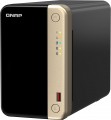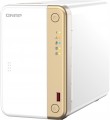LAN ports
The number of LAN ports provided in the design of the NAS server.
LAN — a connector used for a wired connection to Ethernet local networks (the most common "local" format today, it is also used to access the Internet). For a relatively simple network (say, within a medium office),
one LAN port will be enough. However, models are produced where there are more than one such ports, mainly
2 and
4 connectors. They are designed for large networks divided into subnets with separate access to the NAS server: the presence of several LAN connectors allows you to connect each of the subnets directly without using a router. This simplifies the network architecture and optimizes the load.
HDMI
The presence of an
HDMI output in the NAS server; either the presence of such a connector itself or its specific version can be indicated here.
HDMI is a digital interface specifically designed to carry high-definition video and multi-channel audio. This is the most common of these interfaces, most modern monitors, TVs, home theaters, projectors, etc. have this type of input. Thus, even in such a specific technique as NAS servers, such outputs have several applications. The first option is to connect a monitor to monitor the parameters of the server; some devices at the same time allow you to connect keyboards / mice and control the server directly, like a regular computer. The second option is to use the NAS server as a media centre to broadcast movies and other content to a TV, home theater, etc.
The specific functionality of HDMI should be specified separately. As for the versions, the following options are relevant today:
— v 1.4. Relatively old (2009), but still quite widely used version. Supports resolutions up to 4096x2160 (at 24 fps), as well as frame rates up to 120 Hz, which allows you to play 3D content as well. It is found both in the original version and in improved versions v 1.4a and v 1.4b — they have advanced features for working with 3D.
-v 2.0. Version released in 2013. The increased bandwidth compared to its predecessor made it possible to provide full support for 4K video (at frame
...rates up to 60 Hz), as well as multi-channel audio up to 32 channels and 4 streams over a single cable. HDMI v 2.0 did not originally support HDR, however this feature was introduced in the v 2.0a update and was improved and expanded in v 2.0b. With all this, old cables, originally designed for version 1.4, are also suitable for connecting according to this standard.
— v 2.1. Standard introduced in 2017. Also known as HDMI Ultra High Speed, bandwidth has increased so much that it is possible to transmit video at resolutions up to 10K at 120 frames per second. Note that to use all the features of this version, you need cables that were originally created for it (although the functionality of earlier versions will be available when connected via a regular cable).
In conclusion, we note that different versions of HDMI are mutually compatible, however, the signal transmission capabilities in such cases will be limited by the characteristics of the older and slower standard.CPU
The model and specifications of the processor installed in the NAS server. The speed of the device largely depends on these characteristics, primarily the clock frequency. However, in fact, this parameter is often more of a reference value: simple everyday tasks (say, FTP and print servers, see "Software Features") do not require high computing power. But for working with extensive databases (see ibid.), a “faster” processor may be useful.
CPU cores
The number of cores provided in the processor of the NAS server.
Initially, each core is a computing module designed to execute one sequence of instructions. Accordingly, multiple cores make it possible to work simultaneously with multiple data streams, which improves flow Rate - especially when processing multiple tasks at the same time. Also, in modern CPUs, multithreading technologies are increasingly being used, which allow loading each core with two sequences of commands at once. During the inevitable pauses in the execution of one of the threads, the kernel does not idle, but works with another sequence. As a result, the total number of threads in such processors is twice the number of cores; this scheme of work even more noticeably improves flow Rate.
It is also worth remembering that the overall capabilities of the processor are highly dependent on a number of other characteristics - microarchitecture, clock speed, support for special functions, etc. This means that a large number of cores does not in itself guarantee high flow Rate: for example, an inexpensive mobile
processor on 4 cores may well be "weaker" than an advanced desktop chip
with only 2 cores. However, if we are talking about a CPU with a similar specialization and clock speed, then a solution with a large number of cores (
6 cores,
8 cores, or ev
...en more) and multithreading support usually turns out to be more productive.RAM
The amount of RAM on the NAS server. Along with the processor, it is one of the indicators that determine the speed of the system — the more memory, the higher the computing power. However, in fact, it does not always make sense to chase large amounts of "RAM", which can reach
4 GB,
8 GB and even higher; see "Processor" for details.
Max. RAM
The maximum amount of RAM that can be installed on the NAS server. It depends, in particular, on the type of memory modules used, as well as on the number of slots for them.
Power consumption
The amount of power consumed by the NAS server during normal operation. Most often, we are talking about maximum power consumption — with all the occupied slots for drives, under high load.
Modern NAS, even high-performance ones, have rather modest power consumption — even among professional models with 10 or more drives, this figure rarely exceeds 1 kW. So there are no problems with connecting to a 230 V network. However, energy consumption information can be useful for some special applications, primarily for estimating the load on UPSs, emergency generators, stabilizers, and other special equipment.

